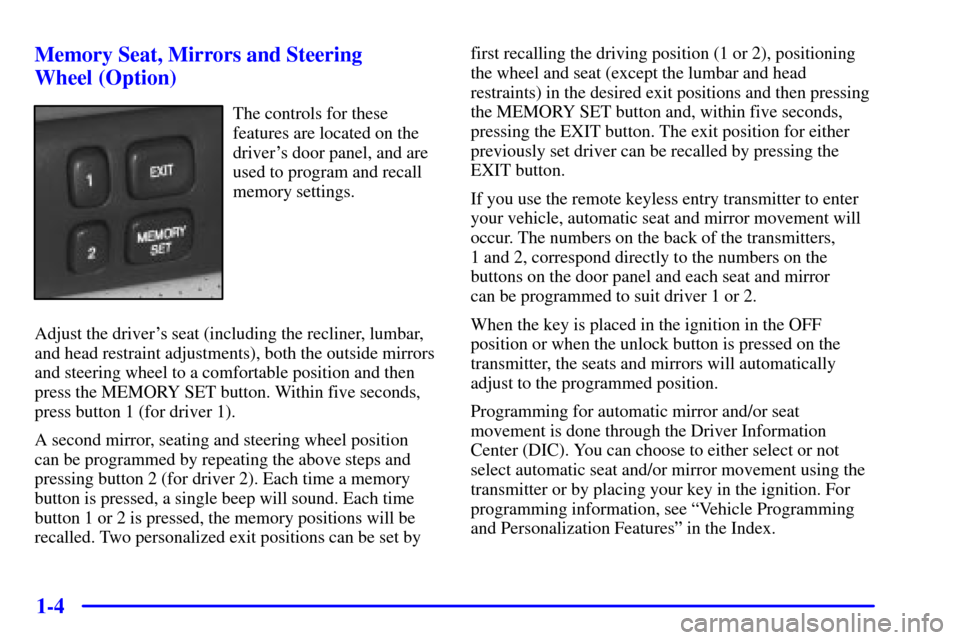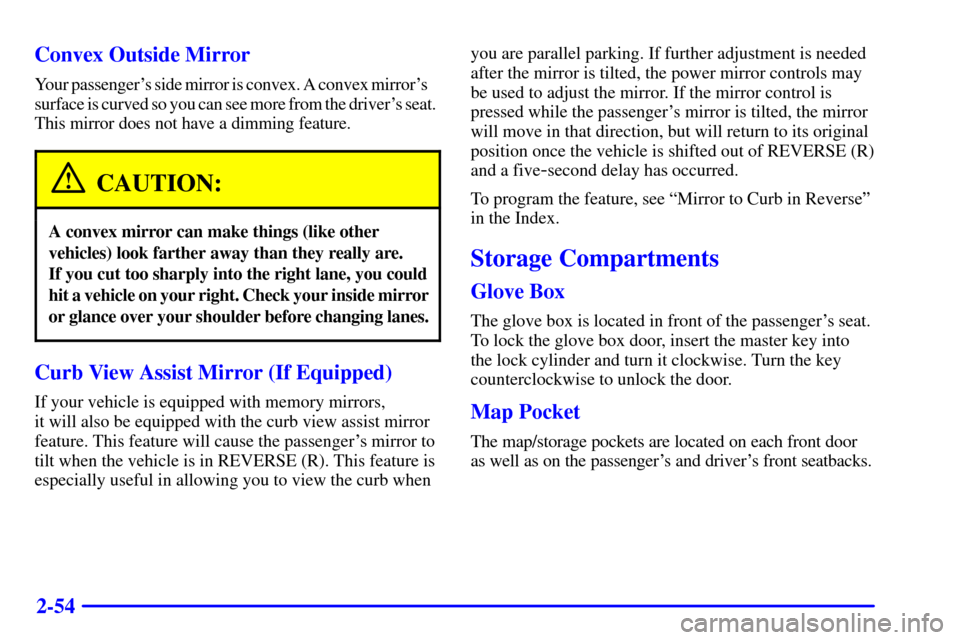Page 14 of 359

1-2
Seats and Seat Controls
This section tells you about the power seats -- how to
adjust them, and also about reclining front seatbacks,
lumbar adjustments, heated seats and head restraints.
Power Seats
The power seat controls are
located on the outboard side
of the front seat cushions.
�Move the front of the seat control up or down to
adjust the front portion of the cushion.
�Move the rear of the seat control up or down to
adjust the rear portion of the cushion.
�Lift up or push down on center of the seat control to
move the entire seat up or down.
�To move the seat forward or rearward, slide the seat
control forward or rearward.
Four Way Power Lumbar Control
(If Equipped)
If you have this feature,
the driver's and passenger's
seatback lumbar support
can be adjusted four ways
by moving a single switch
located on the side of
the seat.
To increase or decrease support, hold the switch forward
or rearward. To move the lumbar up or down, hold the
switch up or down.
Keep in mind that as your seating position changes,
as it may during long trips, so should the position of
your lumbar support. Adjust the seat as needed.
Page 16 of 359

1-4 Memory Seat, Mirrors and Steering
Wheel (Option)
The controls for these
features are located on the
driver's door panel, and are
used to program and recall
memory settings.
Adjust the driver's seat (including the recliner, lumbar,
and head restraint adjustments), both the outside mirrors
and steering wheel to a comfortable position and then
press the MEMORY SET button. Within five seconds,
press button 1 (for driver 1).
A second mirror, seating and steering wheel position
can be programmed by repeating the above steps and
pressing button 2 (for driver 2). Each time a memory
button is pressed, a single beep will sound. Each time
button 1 or 2 is pressed, the memory positions will be
recalled. Two personalized exit positions can be set by first recalling the driving position (1 or 2), positioning
the wheel and seat (except the lumbar and head
restraints) in the desired exit positions and then pressing
the MEMORY SET button and, within five seconds,
pressing the EXIT button. The exit position for either
previously set driver can be recalled by pressing the
EXIT button.
If you use the remote keyless entry transmitter to enter
your vehicle, automatic seat and mirror movement will
occur. The numbers on the back of the transmitters,
1 and 2, correspond directly to the numbers on the
buttons on the door panel and each seat and mirror
can be programmed to suit driver 1 or 2.
When the key is placed in the ignition in the OFF
position or when the unlock button is pressed on the
transmitter, the seats and mirrors will automatically
adjust to the programmed position.
Programming for automatic mirror and/or seat
movement is done through the Driver Information
Center (DIC). You can choose to either select or not
select automatic seat and/or mirror movement using the
transmitter or by placing your key in the ignition. For
programming information, see ªVehicle Programming
and Personalization Featuresº in the Index.
Page 114 of 359

2-54 Convex Outside Mirror
Your passenger's side mirror is convex. A convex mirror's
surface is curved so you can see more from the driver's seat.
This mirror does not have a dimming feature.
CAUTION:
A convex mirror can make things (like other
vehicles) look farther away than they really are.
If you cut too sharply into the right lane, you could
hit a vehicle on your right. Check your inside mirror
or glance over your shoulder before changing lanes.
Curb View Assist Mirror (If Equipped)
If your vehicle is equipped with memory mirrors,
it will also be equipped with the curb view assist mirror
feature. This feature will cause the passenger's mirror to
tilt when the vehicle is in REVERSE (R). This feature is
especially useful in allowing you to view the curb whenyou are parallel parking. If further adjustment is needed
after the mirror is tilted, the power mirror controls may
be used to adjust the mirror. If the mirror control is
pressed while the passenger's mirror is tilted, the mirror
will move in that direction, but will return to its original
position once the vehicle is shifted out of REVERSE (R)
and a five
-second delay has occurred.
To program the feature, see ªMirror to Curb in Reverseº
in the Index.
Storage Compartments
Glove Box
The glove box is located in front of the passenger's seat.
To lock the glove box door, insert the master key into
the lock cylinder and turn it clockwise. Turn the key
counterclockwise to unlock the door.
Map Pocket
The map/storage pockets are located on each front door
as well as on the passenger's and driver's front seatbacks.
Page 314 of 359

6-38
The vehicle should be properly prepared as follows:
�The vehicle should be placed so the headlamps are
25 ft. (7.6 m) from a light colored wall or other
flat surface.
�The vehicle must have all four tires on a perfectly
level surface which is level all the way to the wall or
other flat surface.
�The vehicle should be placed so it is perpendicular to
the wall or other flat surface.
�The vehicle should not have any snow, ice or mud
attached to it.
�The vehicle should be fully assembled and all other
work stopped while headlamp aiming is being done.
�The vehicle should be normally loaded with a full
tank of fuel and one person or 160 lbs. (75 kg) on
the driver's seat.
�Tires should be properly inflated.
�Start the vehicle and rock it to level the suspension.
Headlamp aiming is done with the vehicle low beam
lamps. The high beam lamps will be correctly aimed if
the low beam lamps are aimed properly.The headlamp aiming devices are under the hood near
the headlamps.
If you believe your headlamps need horizontal
(left/right) adjustment, follow the horizontal aiming
procedure. If you believe your headlamps need only
vertical (up/down) adjustment, follow only the vertical
aiming procedure.
Adjustment screws can be turned with an E8 Torx
�
socket or T15 Torx screwdriver.